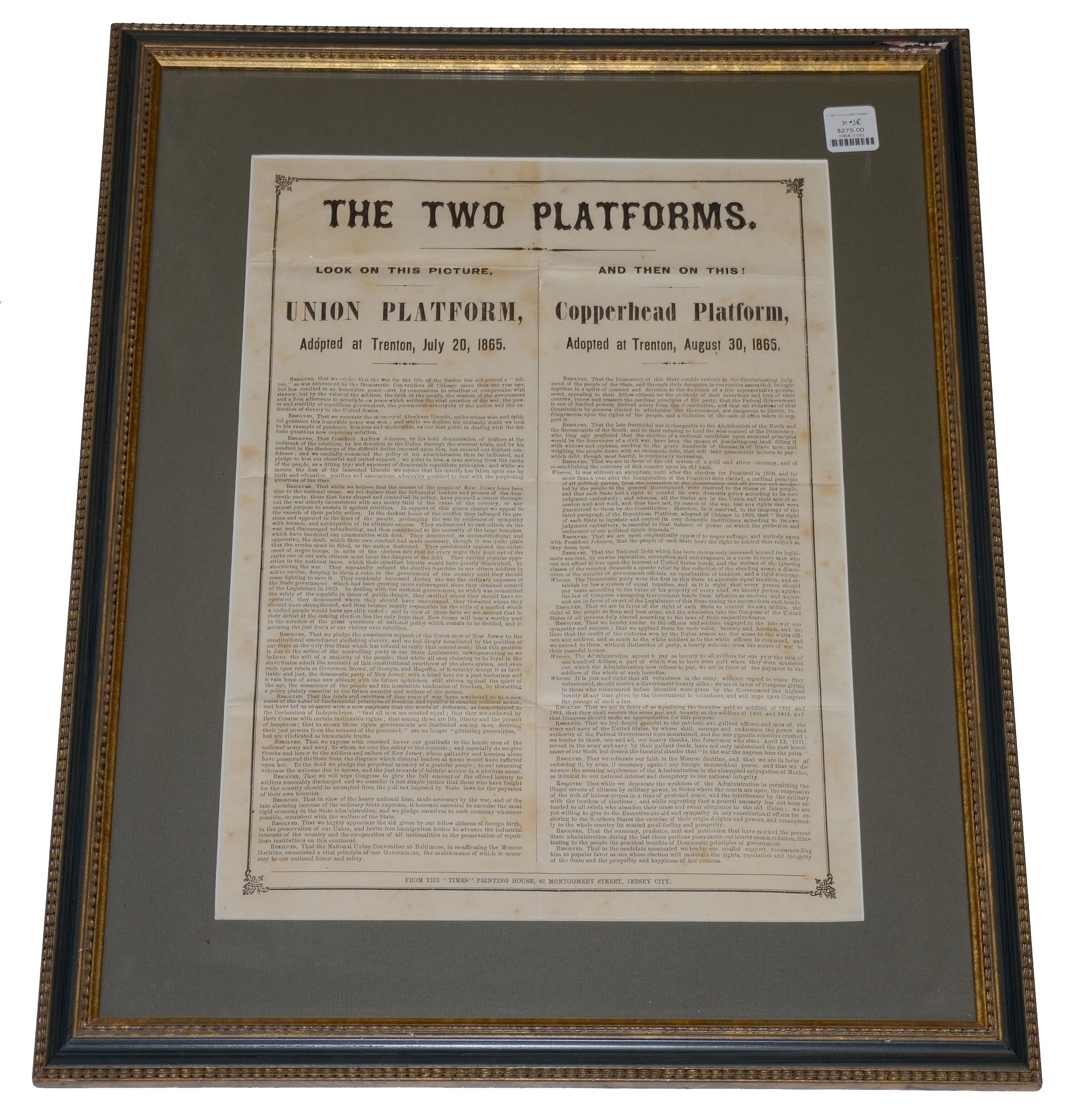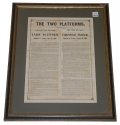site search
online catalog
NEW JERSEY BROADSIDE ON THE GOVERNOR’S RACE AND THE ABOLITION OF SLAVERY BY THE 13th AMENDMENT

$275.00 SOLD
Quantity Available: None
Item Code: 1054-1191
The New Jersey gubernatorial election of 1865 was connected with the fight over the 13th Amendment, abolishing slavery and involuntary servitude except as punishment for a crime. When states took up the ratification of the amendment in February 1865, New Jersey’s Democratic governor and state legislature actually rejected it on March 16. The Fall election for governor, therefore, involved many of the same issues that had dominated the presidential election of 1864.
This two-column broadside printed in Jersey City, shows its preference between the candidates by labeling one platform the “Union Platform” and the other the “Copperhead Platform.” Notably, however, in our day and age of short sound bites, it supports its choice by printing at length the platforms adopted by the two contending parties. The “Union” platform was that of the Republican Party, which adopted the “National Union Party” as a temporary name in the 1864 Presidential election. The “Copperhead Platform,” with all its connotations of violence and treason, was that of the Democratic Party, which had taken the governorship in 1862 and controlled the state legislature since 1859, at least according to the Union platform.
There were other issues at stake and accusations of disloyalty against the Democratic Party, etc., but the question of slavery was front and center in the Republican platform adopted at Trenton on July 20:
“We pledge the unanimous support of the Union men of New Jersey to the constitutional amendment abolishing slavery, and we feel deeply humiliated by the position of our State as the only free State which has refused to ratify that amendment; that this position is due to the action of the controlling party of our State Legislature, misrepresenting as we believe the will of a majority of the people…”
The Democratic Platform adopted at Trenton on August 30, also encompasses other issues and accusations, matters of states rights, national debt, taxation, suspension of habeas corpus, etc., and avoids direct mention of the 13th Amendment, but does not avoid matters of race: “… we are most emphatically opposed to negro suffrage…” Even while trying to balance criticism of the war with praise for the state’s soldiery, the issue reappears in the resolution, “that we . . . believe that the credit of the victories won by the Union armies are due alone to the white officers and soldiers . . .” This purports to be a response to supposed Republican claims that black troops won the war, but serves as a reminder of the charge leveled in the Union Platform that they had opposed the enlistment of black troops altogether, even though from a practical point of view for every black soldier in the ranks there needed to be one fewer, “of our own citizens” who must incur the dangers of the field.
This is a very telling broadside that lays out very plainly some of the issues of the war, Reconstruction, and postwar politics that haunt us still. It is interesting that even immigration becomes an issue. While both sides express gratitude and support to former soldiers, a belief in the Monroe Doctrine, etc., the next to last resolution of the Union Platform brings it up and sets forth their position, in once again very practical terms, “That we highly appreciate the aid given by our fellow citizens of foreign birth, in the preservation of our Union, and invite free immigration hither to advance the industrial interests of the country and the co-operation of all nationalities in the preservation of republican institutions on this continent.”
The outcome of the race was a victory for the Republican candidate, but it was not until January 23, 1866, that the state legislature finally ratified the 13th Amendment. Ironically, it was the states of North Carolina and Georgia who had supplied the crucial twenty-sixth and twenty-seventh votes to reach the necessary three-fourths total of states for the amendment to become take effect.
The broadside itself is in excellent condition with just simple fold lines. It is matted to a size of 11 by 15 inches, with a frame roughly 16 by 20. There is a small bit of damage to the frame at upper right, and also to the plexiglass. These could be replaced for display, but are stable. This is an intensely interesting document showing that many of the issues leading to the war hardly died out with the end of the fighting. [sr]
Extra shipping charge may be required.
Click here for our policy on shipping framed items containing glass.
~~~~~~~~~~~~~~~~~~~~~~~~~~~~~~~~~~~
THIS ITEM, AS WITH ALL OTHER ITEMS AVAILABLE ON OUR WEB SITE,
MAY BE PURCHASED THROUGH OUR LAYAWAY PROGRAM.
FOR OUR POLICIES AND TERMS,
CLICK ON ‘CONTACT US’ AT THE TOP OF ANY PAGE ON THE SITE,
THEN ON ‘LAYAWAY POLICY’.
THANK YOU!
Inquire About NEW JERSEY BROADSIDE ON THE GOVERNOR’S RACE AND THE ABOLITION OF SLAVERY BY THE 13th AMENDMENT
For inquiries, please email us at [email protected]
Most Popular
Historical Firearms Stolen From The National Civil War Museum In Harrisburg, Pa »
Theft From Gravesite Of Gen. John Reynolds »
Cavalry Carbine Sling Swivel »
Fine Condition Brass Infantry Bugle Insignia »
featured item
GREAT LOT OF ACCOUTREMENTS ID'D TO 11TH MASSACHUSETTS BATTERY SOLDIER
This group of items all came together with two wonderful old handwritten tags testifying to the fact that they all belonged to Private James W. Pierce of the 11th Massachusetts Battery. All the items in this group show uniform wear and age and have… (1179-295). Learn More »






